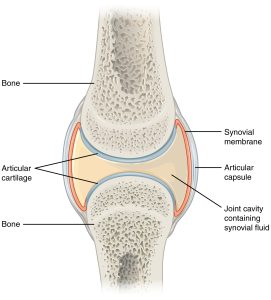Chapter 8: Core and Balance Training Principles
Friction in Joints
Synovial Joint Friction
Static and kinetic friction are both present in joints. Static friction must be overcome, by either muscle tension or gravity, in order to move. Once moving, kinetic friction acts to oppose motion, cause wear on joint surfaces, generate thermal energy, and make the body less efficient. The body uses various methods to decrease friction in joints, including synovial fluid, which serves as a lubricant to decrease the friction coefficient between bone surfaces in synovial joints (the majority of joints in the body). Bone surfaces in synovial joints are also covered with a layer of articular cartilage which acts with the synovial fluid to reduce friction and provides something other than the bone surface to wear away over time. We ignored friction when analyzing our forearm as a lever because the frictional forces are relatively small and because they acted inside the joint, very close to the pivot point so they caused negligible torque.

Reinforcement Exercises
Find a value for the kinetic coefficient of friction between ends of a bone in a synovial joint lubricated by synovial fluid. State your value and your source.
If the normal force between bones in the knee is 160 lbs, what is the kinetic frictional force between the surfaces of the knee bones?

